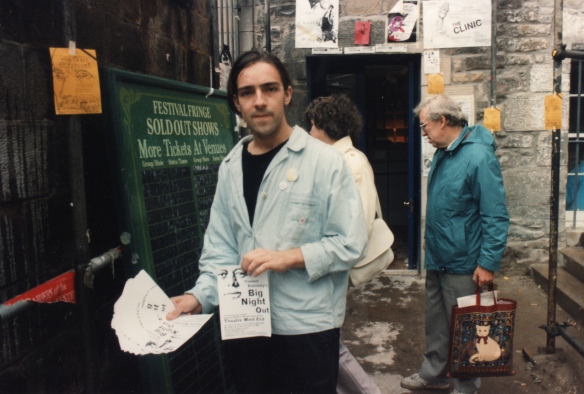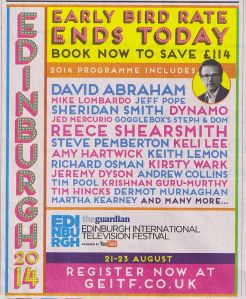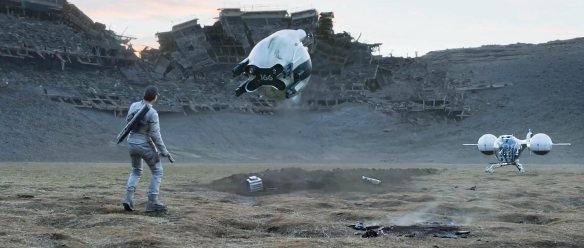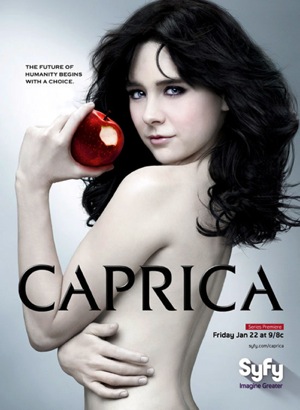
Another year, another Edinburgh. It’s great how you can refer to a trip to what really is my Second City to coincide with the Festival, or Festivals, as “an Edinburgh.” We all know what it means. And it means mostly wonderful things. Before I prepare my report on this year’s three-day piped-bagpipe bagatelle, here’s the traditional shot of me at my first Edinburgh, in 1989.

I feel sure I don’t need to go into detail, but I was two years out of college, one year in the NME art room, far enough into a hair-growing project to produce a nub of a ponytail, and part of a Tooting-based, medical-school-formed am-dram group called Renaissance Comedy Associates; our play, which I co-wrote with co-star Matthew Hall*, was called President Kennedy’s Big Night Out and one or two people paid to see it in a church hall on Princes Street – it was a great adventure, but I didn’t go back until 2001, when the show was Lloyd Cole Knew My Father and we looked like this.

I have been up every year except one ever since. The big shift for me occurred in 2009, when, having been up to do an experimental week of live Collings & Herrin Podcasts at the Underbelly, I was also invited to host, or “chair”, my first session at the Guardian Edinburgh International Television Festival, which – after my heartfelt retirement from stand-up comedy in 2010 and a welcome year off in 2011 – has thereafter been my ticket up there. It being Guardian-sponsored, a short clip of me talking to Andy Hamilton and Guy Jenkin in 2009 is still available to view. My body language says: I am not yet confident enough as a “chair” to sit properly in one.

I like to think I am now a far more confident host. Once you’ve done your first live gig as “facilitator” – whose brief is to introduce the session, get the best out of your interviewees (ie. “facilitate” their illuminating answers), move the thing along, hit the clips at the right moment, coordinate a short audience Q&A at the end and exude approachable authority – you start to get into a rhythm of being miked up, having a producer bark into your ear via an earpiece, knowing when to skip a huge chunk of questions for time, and being unclipped from your mic at the end (always courteous and grateful to the venue staff, as without them you would not be miked up, or able to reach for a sip of water, or even know where the hell to go in the warren of suites, green rooms and auditoria). I am not staff. I am not paid to do this work, but the Festival does pay my train fare and puts me up in a serviceable hotel (the one you can guarantee none of the big stars will be staying in – I know my place). Most importantly, it gives me the chance to be here.

I have rhapsodised Edinburgh aplenty. In a way, I’m the wrong person to ask about the city as I’ve literally only ever stepped foot on the platform of Waverley Station during the Festival. This is clearly not what life is like in Edinburgh for the other 11 months of the year (except for the weather and the novelty drunks and the souvenir shops piping out bagpipe music). But I have made friends up here who do live in Edinburgh and adjoining Dunfermline, so it’s not as if I only hang out with London media wankers like myself. I made enough friends when I was a stand-up to be able to sneak in to see a couple of their shows while I’m up here, which is always a bonus, and I make an effort to conceal or remove my pink, YouTube-sponsored TV Festival pass when I’m walking down the street. I certainly stride maplessly about the place like I own it, which I hope stops me ever looking like a tourist.

Because I always come on my own, what I do feel like is a travelling salesman. Especially at breakfast.

I’ve been a regular at Apex hotels for the past couple of Festivals: no-nonsense places but a cut above a Best Western or Novotel (and I say that not as a hotel snob but as someone whose default, austerity overnight is a Travelodge if I’m paying the bill). This year, for no apparent reason, I was placed in a Hilton. I’m worldly-wise enough to know that the “Hilton” logo does not automatically speak of glamour and the high life. It’s just a hotel chain, a Premier Inn that fancies itself.
There are a couple of Hiltons in Edinburgh (which shows how exclusive they’re not) and I think I was in the least glamorous Hilton. I don’t expect to live like a king – all I require is a bed, wi-fi, a full Scottish breakfast and a free paper. The Hilton gives away the digest version of the Independent whose actual name looks like a mistake of you type it: the i. I’ve never had a minibar. Luckily, I don’t demand a room with light in it either, as this year I was in a non-air-conditioned basement whose windows were painted shut and which was illuminated only by tiny desk lamps (the only fitted ceiling light was in the tiny hallway). I did not complain. I was not paying for it. There was free shortbread with the tea- and coffee-making facilities. I thought: I am living the dream.

The title of this blog entry refers not to Scotland’s forthcoming independence – a matter much discussed and a passion-fuelled debate I felt fortunate to have landed in the middle of at the height of national indecision – but my own current independence. Travelling alone, essentially being on holiday alone (even for three days), is replenishing for the soul, I find. I did plenty of solo travelling when I was a much younger music journalist, and it hardened me up. I flew to Dublin for three hours last week to interview Cillian Murphy for Radio Times and I felt a bit like an international jetsetter, albeit one too intrinsically stingy to pay for a fucking coffee on the plane, especially as the otherwise courteous Aer Lingus declined to offer any of us a free drink while we sat on the tarmac at Dublin for two hours, the mercenary bastards.
I arrived in Edinburgh on Wednesday afternoon alone, declined to pay for a cab and thus walked, with my rucksack, to the Hilton, which was 30 minutes away, alone. Checked in alone, unpacked alone etc. etc., you get the manly picture. And within the hour I was back out, alone, marching towards my favourite venue, The Stand, to pick up my ticket to see my friend Josie Long, alone. I bought some fish chowder, which came in a bowl made of bread, from a stall at the new Fringe hub, St Andrew Square Gardens, whose convenience actually prevented me from making my annual day-one pilgrimage to the Pleasance. (This will be the first Edinburgh ever where I haven’t had a pint at the Pleasance. Time bends.) I bought my ceremonial first pint in a plastic glass and sat, alone, among booming revellers, to silently eat my soup and drink my lager. I was happy enough. Edinburgh is full of groups and couples and families at this time of year, but also solo artists, like me. You’re never alone with a plastic pint glass: it is your passport to sit anywhere and just be.

I do regret only seeing one Fringe show this year (I usually squeeze in at least three), but I do not regret choosing Josie Long‘s. It’s been a few years since we were buddied up by 6 Music (and then let go with an empty promise to have us back on – not bitter about that), and even longer since I first met her in a pub basement and offered to hold her indie coat while she sang Nothing Compares 2 U at Karaoke Circus, so I feel I can praise her new direction without being too partisan.
After years of building up her unique and deeply-felt political persona, this year’s show, Cara Josephine (a title movingly explained in the final section), is a left turn. Or a right turn, since she’s already so far to the left. It’s a personal show about heartbreak and failed relationships and being “on the shelf” at 32 that’s quite a jolt if you know her stuff. But it’s delivered in such a way that, while contextually shocking in places (and actually really challenging at one particularly raw and graphic juncture, which I won’t spoil), it’s still Josie being who she is, with her American accents and her self-effacement and righteous ire always bubbling under the surface. It may even be her best show, although that needs to be taken in context. Nobody can accuse her of coasting, that’s for sure.

Back to the picture at the top, which I repeat for reference and which, for all the world, looks like a triumphant stand-up gig, or perhaps a rally, but is actually me introducing an exclusive, public screening of the new Doctor Who episode, Deep Breath, at the mighty Filmhouse cinema on Lothian Road, which has been my de facto base for three years. We screened Asylum Of The Daleks two years ago, with a fabulous Q&A with Steven Moffat afterwards. This, blurrily, was it: 
No Q&A this time, but the preview itself was enough to pack the 280-seater auditorium of Cinema 1 with enthusiasts of all ages. I did a warm-up and by a show of hands (my fallback warm-up technique) established that we had kids in who were too young to remember when David Tennant regenerated into Matt Smith, and at least a couple of gentlemen who remembered seeing the first ever episode! It was pretty easy to get them excited before the screening, as they arrived pre-excited.
It was fun to be part of, and the episode itself is pretty damn good, with Peter Capaldi’s Twelfth Doctor a real shot in the franchise’s arm – his very Scottishness seems to have reinvigorated Moffat’s writing: the 80-miute episode is overlong but full of great jokes, including a couple “about” the Referendum. On Friday morning, in the noisy lobby of the Edinburgh International Conference Centre, hub of the TV Festival, I filmed a special Telly Addict review of the episode for the Guardian with my usual producer Tom, busked rather than read from autocue, as we didn’t have one, and it will go live right after the episode airs on BBC1 this evening.

Thursday also had me manhandling the roving mic for an industry session back in the EICC and another exclusive screening: the pilot of a new, grown-up romantic comedy called Catastrophe, written by and starring Sharon Horgan and Rob Delaney, produced by Avalon (who also manage me) for C4, and due next year. I “met” them both via Twitter on the train up to Edinburgh and we got on famously. This can happen. It was a buzz to see the creators of a show experience their work with a large audience of their peers, and to soak up the constant laughter. It was an easy Q&A, as it was always going to be, but you wouldn’t believe how panicky PRs and managers get beforehand, as if perhaps I was going to bypass how Sharon and Rob wrote the show in the 15 minutes available and ask them a series of improper, probing personal questions to make them squirm and stutter.
Having been out so late on Wednesday night with my two go-to Edinburgh pals Tony and Helen that two bars shut in our faces, forcing us to go to a much nastier one for a final round, I took it easy on Thursday and retired to my dark room early with a chalice of Stella from the hotel bar to sip with two free sticks of shortbread and watch the world burning on the news with the sound down. (Full disclosure: my manager bought me a posh burger and a beer in a posher hotel than my own, and I did a short spin of the National Museum of Scotland where ITV held their annual TV Fest drinks to discover that I only knew one person in the cavernous space, Badults producer Izzy, whom I was most grateful to talk to.)
 We’ll come to the impish, slumped fellow to my right in a moment. Friday was the biggest mountain to climb, with the biggest names to facilitate. It was halfway through the afternoon when I remembered how easy it is to miss entire mealtimes when you’re working the Festival. I’d had my hearty breakfast of course, while weeping lonely tears into the Islamic State headlines in my i (simply doesn’t work, does it? What the hell were they thinking?), but the Guardian filming ran into a session I was keen to attend asking how the US “showrunner” model can be introduced into UK drama production (conclusion: it can’t), and that ran into my first session as host. I did the least imaginative thing possible in the world and ate a warmed-up panini in Caffe Nero for the loyalty stamp in about five minutes flat. Here is a photo of that session, taken by @Missread, my favourite photo of Edinburgh 2014:
We’ll come to the impish, slumped fellow to my right in a moment. Friday was the biggest mountain to climb, with the biggest names to facilitate. It was halfway through the afternoon when I remembered how easy it is to miss entire mealtimes when you’re working the Festival. I’d had my hearty breakfast of course, while weeping lonely tears into the Islamic State headlines in my i (simply doesn’t work, does it? What the hell were they thinking?), but the Guardian filming ran into a session I was keen to attend asking how the US “showrunner” model can be introduced into UK drama production (conclusion: it can’t), and that ran into my first session as host. I did the least imaginative thing possible in the world and ate a warmed-up panini in Caffe Nero for the loyalty stamp in about five minutes flat. Here is a photo of that session, taken by @Missread, my favourite photo of Edinburgh 2014:

A year ago – inspired by seeing the popularity of a session with Vince Gilligan at the TV Festival – I wrote a piece for the Guardian about showrunners. In researching it, I discovered Des Doyle, an Irish filmmaker who was Kickstarting a feature-length documentary about the US TV industry called Showrunners. I plugged it and quoted it in the piece, as you could tell by the trailer than it was going to be an authoritative treat for TV geeks and Yankophiles like me. Well, the extra funding came in, and he finished it, and it’s being released here and in the States in October. It was a pleasure to be able to screen it for the public as well as delegates, as it’s a cracking piece of work, and we’d secured the great Ron D. Moore for a Q&A (he’s the genius behind Battlestar Galactica if you don’t know the name – a wise, softly-spoken sage who happens to be in Scotland to shoot his latest opus Outlander).
In the picture above you can see both Des and me looking adoringly at Ron. This is what a TV festival should be like. It’s all very well to be “industry” and all dry and po-faced about telly, but at heart we should all be fans of the medium and of those who make it, even if, technically, they are our peers. (Our Q&A was foreshortened by The Next Thing, as these events tend to be on this media merry-go-round, but it was great to be in his aura and chat offstage to him about “that” Portlandia sketch.)

Thanks to @envypost for the borrow of the above moody photo, by the way.
Dynamo, boyish 31-year-old underground-overground star of Magician Impossible (whose forthcoming fourth series has been announced as his last for the channel Watch), is a different kettle of fish to anyone I’ve ever facilitated. Although the industry panel we did was conventional (see: above), with his producer/confidsnt Dan, Lucy from Phil McIntyre who manage him, and Richard from the channel, fanned around the coffee table onstage with me in the middle, and with clips playing on the big screen above, the subject – a television show – was not. How do you get under the bonnet of a show whose very beating heart is illusion (what Dynamo prefers to call “events” rather than “tricks”) and to which the question, “How did you do that?” is not only inapplicable, it’s downright rude.
For my intro, I borrowed the quote from Walter Bagehot, 19th century essayist, who warned, “We must not let daylight in upon magic.” And I hope we didn’t, and yet I hope we did a bit. If you’ve not seen Dynamo’s work – indebted to both the street style and spectacle of David Blaine, but without the wankiness – look him up on YouTube or Catch Up. It’s quite unique, as is the way he just walks off after doing something amazing, while Dan’s camera stays on the amazed. Dynamo might have turned out to be a tricky customer in real life, but he was sweet, funny and self-aware, and more than able to deal with a large auditorium. (He’s taking a break from TV to do a live tour, by the way.) When he did a bit of magic, and melted the hearts of even the stoniest TV miseryguts in the audience I think, I was right there next to him. I saw him turn some Lottery tickets into £20 notes by just shaking them. If they were “special” ones, I don’t know how they worked. He also turned his hand all the way round on his wrist, and swapped a playing card he held in his mouth with the playing card held in the mouth of a female volunteer. I know it’s magic, but Iogic disappears when you see someone as cool and casual as Dynamo do it.
The industry session was followed by a public screening, back at the Filmhouse. Sold out, of course, with a crowd that needed even less warming up from me than Doctor Who‘s. We watched Ep1 of his new, typically globe-trotting, celeb-packed series (showing on Watch in September), and Dynamo slipped into the seat next to me in the dark, mid-screening, to soak up the audience reaction. A small child in the row in front turned round and saw him and it was like he’d seen Jesus. After the Q&A, during which he did more magic, he was literally mobbed, enveloped, subsumed by disciples. He’s a star of the Instagram Age and he understands the power of that, but it was still incredible to see how patiently and diligently he gave them all the time they individually craved. Here’s a selfie he had taken with a volunteer, @DimpleMagician:
His popularity, that kid-from-Bradford approachability and a superstar’s diligence combined to become a health and safety issue. I slipped out into the bar to have a chat to my Dunfermline pal Paul (whose daughter – who was such a fan she’d done a school project on Dynamo – queued patiently with her mum to get the now standard autograph/selfie) and realised that, without any warning, my working holiday was over. And it had stared raining.

It was with a little sadness that I ate my last breakfast this morning, and packed my bags. I got absolutely soaked through on the walk home last night in the statutory proper Edinburgh downpour, but along the way (I was too mean, and too wet already, to hail a cab), I saw women without jackets or coats, let alone umbrellas or kagoules, determined to have a Friday night out regardless. You have to love the north. The Scots are already independent, spiritually and behaviourally, and Alex Salmond’s million signatures were reached yesterday, but I still fear the don’t-knows will win the day and Scotland will remain adjoined more than just geographically to the bit of the country that votes in Tory governments. (Capaldi’s Doctor blames the English for his woes in Deep Breath.) I will still love them as anyone might love a different tribe who almost speak the same language.
My last memory of Edinburgh 2014 will be sitting in wet jeans in the Hilton bar with a burger and a chalice of Stella, reading Charlotte Higgins’ brilliant, eloquent but depressing final analysis of the BBC in the Guardian, the newspaper that sponsors the Festival that pays my train fare and gives me the golden opportunity to see auld acquaintances annually, and asks me to busk a review of Doctor Who in a lobby. See you in 2015, yes?
Or should that be: see you in 2015, YES.
*Oh, Matthew Hall changed his name to Harry Hill. Whatever happened to him?













